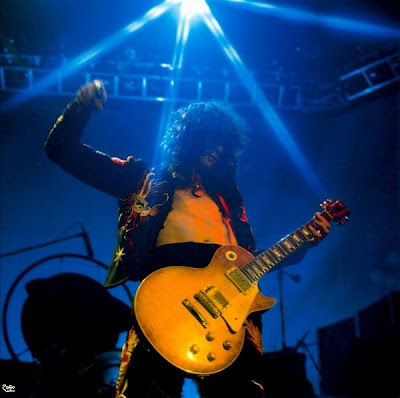
Led Zeppelin is the eponymous debut album of English hard rock band, Led Zeppelin. It was recorded in October 1968 at Olympic Studios in London and released on Atlantic Records on January 12, 1969. The album featured integral contributions from each of the group's four musicians and established Led Zeppelin's unique fusion of blues and rock. Led Zeppelin also created a large and devoted following for the band, with their unique heavy metal and psychedelic rock sound endearing them to a section of the counterculture on both sides of the Atlantic.
In August 1968, the English rock group The Yardbirds had completely disbanded. Guitarist Jimmy Page, The Yardbirds' sole remaining member, was left with rights to the group’s name and contractual obligations for a series of concerts in Scandinavia.[1] For his new band, Page recruited bassist John Paul Jones, vocalist Robert Plant and drummer John Bonham. During September 1968, the group toured Scandinavia as The New Yardbirds, performing some old Yardbirds material as well as new songs such as "Communication Breakdown", "I Can't Quit You Baby", "You Shook Me", "Babe I'm Gonna Leave You" and "How Many More Times".[2] The month after they returned to England, October 1968, Page changed the band's name to "Led Zeppelin", and the group entered the studio to record their debut album.
Led Zeppelin's front cover, which was chosen by Page, features a black-and-white image of the burning Hindenburg airship. The image refers to the origin of the band's name itself:[10] as the story goes, when Page, Jeff Beck and The Who's Keith Moon and John Entwistle were discussing the idea of forming a group, Moon joked, "It would probably go over like a lead balloon". To which Entwistle allegedly replied, "...a Lead Zeppelin!" The album's back cover features a photograph of the band taken by former-Yardbird Chris Dreja. The entire design of the album's sleeve was coordinated by George Hardie, with whom the band would continue to collaborate for future sleeves.
Hardie recalled that he originally offered the band a design based on an old club sign in San Francisco—a multi-sequential image of a phallic zeppelin airship up in the clouds. Page declined but it was retained as the logo for the back cover of Led Zeppelin's first two albums and a number of early press advertisements. During the first few weeks of release in the UK, the sleeve featured the band's name and the Atlantic logo in turquoise. When this was switched to the now-common orange print later in the year, the turquoise-printed sleeve became a collector's item.
Led Zeppelin was produced by Jimmy Page and engineered by Glyn Johns, who had previously worked with The Beatles, The Rolling Stones and The Who. The album was recorded on an analog 4-track machine, which helped to give the record its warm sound. Page reportedly used natural room ambience to enhance the reverb and recording texture on the record, demonstrating the innovations in sound recording he had learned during his session days. Up until the late 1960s, most music producers placed microphones directly in front of the amplifiers and drums. For Led Zeppelin Page developed the idea of placing an additional microphone some distance from the amplifier (as far as twenty feet) and then recording the balance between the two. By adopting this "distance equals depth" technique, Page became one of the first producers to record a band's "ambient sound" -- the distance of a note's time-lag from one end of the room to the other.
Another notable feature of the album was the "leakage" on the recordings of Robert Plant's vocals. In an interview Page gave to Guitar World magazine, Page stated that "Robert's voice was extremely powerful and, as a result, would get on some of the other tracks. But oddly, the leakage sounds intentional."
On the track "You Shook Me", Page used his "backward echo" technique, which involved hearing the echo before the main sound instead of after it, achieved by turning the tape over and employing the echo on a spare track, then turning the tape back over again to get the echo preceding the signal. Page had originally developed the method when recording the single "Ten Little Indians" with The Yardbirds in 1967
Led Zeppelin's album cover received widespread attention when, at a 28 February 1970 gig in Copenhagen, the band were billed as "The Nobs" as the result of a threat of legal action from aristocrat Eva von Zeppelin (a relative of the creator of the Zeppelin aircraft), who, upon seeing the logo of the Hindenburg crashing in flames, threatened to have the show pulled off the air.
ZEP ONE
2 comments:
Hey, I'm a bit of a wino myself!
I haven't been able to find my CDs (they're in storage under some boxes) so I DL'd Led Zeppelin I, but it's asking for a password and nothing I've tried (mud, http://electricmud.blogspot.com/, electricmud.blogspot.com) works. Am I doing something wrong or have I just overlooked something in the writeup?
I appreciate the posting.
Ferd
It should be updated now
Cheers
Post a Comment